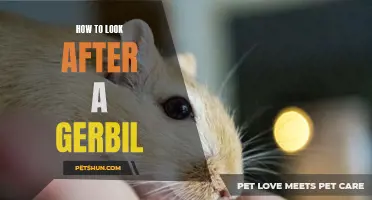
Gerbils make great pets, but often get overlooked in favor of more traditional pet choices like cats or dogs. However, these small, furry creatures can bring lots of joy and entertainment to a household. But before bringing a gerbil home, it's important to understand their specific needs, especially when it comes to their cage. Providing the right cage requirements is essential for their health and happiness, and can make all the difference in creating a safe and comfortable environment for these little critters to thrive in. So, let's take a closer look at what exactly a gerbil's cage should include to ensure they are living their best life.
| Characteristics | Values |
|---|---|
| Size | At least 12 x 24 x 12 inches (30 x 60 x 30 cm) |
| Cage Material | Wire with narrow bars or glass aquarium with a wire mesh top |
| Flooring | Solid plastic or thick cardboard or shredded paper bedding |
| Accessories | Exercise wheel, tunnels, hideouts, chew toys |
| Ventilation | Good airflow with ventilation holes or wire mesh |
| Cleaning | Easy to clean with removable trays or slide-out bottoms |
| Security | Secure latches or locks to prevent escapes |
| Bedding | Non-toxic and absorbent materials like paper bedding or aspen shavings |
| Food and Water | Separate bowls or bottles for food and water |
| Temperature | Kept in a room between 65-75°F (18-24°C) |
| Lighting | Natural light or full-spectrum light for proper day-night cycle |
| Noise Level | Quiet or low noise environment to minimize stress |
| Escape-proofing | No gaps or openings that gerbils can squeeze through |
| Multi-level | Multiple levels or platforms for exercise and climbing |
| Nesting Area | A cozy area with nesting materials like shredded paper or hay |
| Interaction | A door or access point for easy handling and interaction |
| Enrichment | Various toys and activities to keep gerbils mentally stimulated |
| Substrate | At least 3-4 inches (8-10 cm) of bedding for burrowing and tunneling |
| Chewing | Safe and durable chew toys to satisfy their chewing instincts |
| Privacy | Hideouts or tunnels for gerbils to retreat and have privacy |
| Maintenance | Regular cleaning and disinfecting to maintain hygiene |
| Security | Durable and secure construction to prevent predators from getting in |
| Accessibility | Easy access to food, water, and toys for gerbils |
| Sanitation | Regular cleaning of the cage and changing of bedding to prevent odor and bacteria buildup |
What You'll Learn
- What are the minimum dimensions for a gerbil cage?
- What types of materials are suitable for a gerbil cage?
- Do gerbils need multiple levels or platforms in their cage?
- How often should a gerbil's bedding be changed?
- Are there any specific food or water requirements for gerbils that need to be considered when designing their cage?

What are the minimum dimensions for a gerbil cage?
Gerbils are small, active, and social rodents that make great pets. One of the most important considerations when getting a gerbil is providing them with a suitable habitat, as they require plenty of space to explore, exercise, and socialize. In this article, we will discuss the minimum dimensions for a gerbil cage to ensure their happiness and well-being.
Scientific research has shown that gerbils need a minimum floor space of 10 to 20 gallons per pair of gerbils. However, it is always best to provide them with as much space as possible to promote their natural behaviors and prevent boredom. A larger cage will give gerbils more opportunities to run, dig, climb, and explore.
Experience has shown that a wire cage with a solid and durable plastic base is a popular choice for gerbil owners. The wire top allows for proper ventilation while the plastic base provides a safe and secure environment. It is important to ensure that the bars are spaced closely enough to prevent escape, as gerbils are excellent chewers and can squeeze through small openings.
Step-by-step, here are the key considerations when choosing the minimum dimensions for a gerbil cage:
- Height: Gerbils love to climb, so a tall cage with multiple levels and platforms will keep them entertained. Aim for a height of at least 12 inches.
- Length: Gerbils need room to run and play, so the length of the cage is crucial. A minimum length of 24 inches is recommended, but the more space you can provide, the better.
- Width: Gerbils also need space to dig and burrow, so a wider cage is important. Aim for a width of at least 12 inches, but again, the more space the better.
- Bar spacing: Make sure the bars of the cage are spaced no more than ¼ inch apart to prevent escapes.
Examples of suitable gerbil cages include:
- A cage measuring 24 inches in length, 12 inches in width, and 12 inches in height, with multiple levels and platforms for climbing.
- A larger cage measuring 36 inches in length, 18 inches in width, and 18 inches in height, with plenty of space for digging, running, and playing.
Remember, these are the minimum dimensions for a gerbil cage. The more space you can provide, the happier and healthier your gerbils will be. Consider adding tunnels, hiding spots, and toys to enrich their environment and encourage natural behaviors.
In summary, gerbils require a cage with a minimum floor space of 10-20 gallons per pair of gerbils. A wire cage with a solid plastic base is recommended, with a height of at least 12 inches, a length of 24 inches or more, and a width of 12 inches or more. Providing ample space for climbing, running, and digging will ensure your gerbils have a happy and enriched home.
The Mysterious World of the Grey Gerbil: Exploring the Fascinating Traits and Behavior
You may want to see also

What types of materials are suitable for a gerbil cage?
When it comes to providing a suitable environment for your pet gerbil, one important aspect to consider is the material used for their cage. Gerbils are active animals that love to dig, explore, and burrow. Therefore, it is essential to choose materials that are safe, durable, and comfortable for your furry friend. In this article, we will explore some of the best materials for a gerbil cage.
Glass
Glass tanks or terrariums are commonly used as gerbil cages. They provide excellent visibility and prevent the gerbil from escaping. Additionally, glass is easy to clean and does not absorb odors. Make sure to choose a tank with a secure lid to prevent any accidents. A tank with a minimum size of 10 gallons is suitable for one or two gerbils.
Plastic
Plastic cages specifically made for small pets like gerbils can be a good option. Look for cages made of sturdy and non-toxic plastic, as gerbils have a tendency to chew on cage bars. Make sure the plastic is thick enough to prevent your gerbil from escaping. Look for cages with multiple levels and tunnels to provide enrichment for your gerbil's natural behaviors.
Wire Mesh
Wire mesh cages are another popular option for gerbil owners. They provide good ventilation and allow the gerbils to climb and explore. However, it is crucial to ensure that the spacing between the wires is small enough to prevent your gerbil from escaping or getting stuck. Also, be cautious of cages with a wire-bottom, as this can cause injuries to your gerbil's feet. If you choose a wire cage, provide plenty of bedding material to cushion the bottom.
Wood
Wooden cages can be a great choice for gerbils. They provide a natural and comfortable environment for your pet. However, it is important to select a cage made from untreated wood, as gerbils may chew on the cage. Cedar and pine wood should be avoided, as they can release harmful fumes that could harm your gerbil's respiratory system. Look for cages made of birch, poplar, or pine that have been kiln-dried for safety.
DIY Options
If you are feeling creative, you can build your own gerbil cage using various materials. For example, you can create a cage using a plastic storage bin with ventilation holes drilled on the sides. This option allows for customization and can be a cost-effective solution. However, ensure that the materials used for DIY cages are safe and non-toxic for your gerbil.
In conclusion, there are several materials suitable for a gerbil cage. Glass, plastic, wire mesh, wood, and DIY options can all provide a safe and comfortable environment for your pet. When choosing a cage material, consider your gerbil's needs, behavior, and safety. Providing an appropriate cage will help ensure that your gerbil lives a happy and healthy life.
The Right Amount of Space for Gerbils: What You Need to Know
You may want to see also

Do gerbils need multiple levels or platforms in their cage?
Gerbils are small, curious rodents that make great pets. When setting up a gerbil cage, it's important to create an environment that allows them to explore, exercise, and fulfill their natural instincts. One way to achieve this is by providing multiple levels or platforms in their cage. In this article, we will explore why gerbils need multiple levels or platforms and how to set them up effectively.
Gerbils are naturally active animals that love to run, climb, and explore. By providing multiple levels or platforms in their cage, you are giving them the opportunity to exercise and engage in their natural behaviors. Platforms can be in the form of shelves, ramps, or even tunnels that connect different levels. These structures not only add a three-dimensional aspect to their living space but also provide mental stimulation as they navigate and climb.
One of the main benefits of having multiple levels or platforms is that it allows gerbils to utilize the vertical space in their cage. Gerbils are known for their digging abilities and love to create complex tunnel systems. By adding platforms, you are effectively creating more surface area for them to explore and utilize. This helps to prevent boredom and promotes physical and mental stimulation.
Another reason why gerbils need multiple levels or platforms is to promote their natural instinct for nesting and burrowing. Gerbils are desert animals and naturally seek out enclosed spaces to build their nests and burrows. By providing platforms in their cage, you are giving them the opportunity to create multiple levels of nests and tunnels. This mimics their natural habitat and allows them to feel safe and secure.
When setting up multiple levels or platforms in a gerbil cage, it's important to consider their safety. Make sure the materials used are safe for gerbils and do not have any sharp edges that could injure them. The platforms should be securely attached and stable to prevent any accidents. It's also important to provide enough space for gerbils to move comfortably between levels and platforms.
A good way to set up multiple levels or platforms is by using wire mesh shelves or wooden platforms. These materials are safe for gerbils and provide a stable surface for them to walk on. You can attach the shelves or platforms to the sides of the cage using screws or hooks. Be sure to space them out at different heights to create a multi-level environment.
In addition to shelves or platforms, you can also add tunnels or tubes that connect different levels. Gerbils love to explore and will enjoy climbing through tunnels and tubes. Again, make sure these structures are secure and do not have any sharp edges.
To make the multiple levels or platforms even more interesting for your gerbils, you can add bedding material or nesting material on each level. This will encourage them to create nests and tunnels in different areas of their cage.
In conclusion, gerbils benefit from having multiple levels or platforms in their cage. It allows them to exercise, fulfill their natural instincts, and provides mental stimulation. When setting up multiple levels, make sure to prioritize their safety and provide stable surfaces for them to walk on. Adding tunnels and nesting material can further enhance their living environment. By creating a multi-level cage, you are providing your gerbils with a stimulating and enriching home.
The Best Tips for Creating a Gerbil Enclosure to Keep Your Furry Friend Happy and Healthy
You may want to see also

How often should a gerbil's bedding be changed?
Gerbils are small rodents that make great pets. However, like all pets, they require proper care and maintenance to ensure their health and well-being. One important aspect of gerbil care is maintaining a clean living environment, which includes regular bedding changes. But how often should a gerbil's bedding be changed? In this article, we will explore the factors that influence the frequency of bedding changes for gerbils.
Proper bedding is essential for gerbils as it serves multiple purposes. It provides them with a comfortable place to sleep, helps to regulate their body temperature, and absorbs moisture and odors. However, bedding can become soiled over time, leading to an unhygienic and potentially harmful environment for gerbils.
The frequency of bedding changes for gerbils depends on various factors such as the type of bedding used, the number of gerbils in the enclosure, and the general cleanliness of the living area. Let's delve into these factors to determine the optimal schedule for bedding changes.
- Type of Bedding: There are several options available when it comes to gerbil bedding, including wood shavings, paper-based bedding, and even recycled paper pellets. Each type has its own absorption capabilities and odor-controlling properties. Wood shavings, such as aspen or pine, are popular choices but may require more frequent changes than paper-based bedding due to their lower absorbency. On the other hand, paper-based bedding tends to be more absorbent and can typically last longer before needing to be replaced.
- Number of Gerbils: The number of gerbils in the enclosure also plays a role in determining how often bedding should be changed. More gerbils in a confined space produce more waste and moisture, leading to quicker saturation of the bedding. If you have multiple gerbils sharing an enclosure, it is advisable to change the bedding more frequently to ensure a clean and healthy environment for them.
- Cleanliness: Regular spot cleaning and maintenance of the gerbil's enclosure can help prolong the lifespan of the bedding. Removing soiled bedding or uneaten food on a daily basis can significantly reduce the accumulation of waste and odors. By keeping the gerbil's living area clean, you can extend the time between full bedding changes.
As a general guideline, it is recommended to change gerbil bedding at least once a week. However, this timeframe may need to be adjusted based on the factors mentioned above. If you notice a strong odor, excessive wetness, or signs of mold or bacteria growth in the bedding, it is a good indication that it needs to be changed more frequently.
Additionally, if your gerbil becomes ill, it is crucial to change the bedding immediately to prevent the spread of any potential infections or diseases. A sick gerbil will have a compromised immune system, making them more susceptible to secondary infections from unsanitary bedding.
In conclusion, maintaining a clean living environment for your gerbils is vital for their overall health and well-being. The frequency of bedding changes depends on various factors such as the type of bedding used, the number of gerbils in the enclosure, and the cleanliness of the living area. By considering these factors and regularly monitoring the condition of the bedding, you can ensure that your gerbils have a clean and comfortable habitat to thrive in.
5 Different Types of Gerbils for Pets
You may want to see also

Are there any specific food or water requirements for gerbils that need to be considered when designing their cage?
When designing a cage for gerbils, it is important to consider their specific food and water requirements. Gerbils are small rodents that have unique dietary needs and preferences. Providing the appropriate food and water sources is essential for their health and well-being.
First and foremost, gerbils require access to fresh, clean water at all times. This can be achieved by providing a water bottle with a sipper tube attached to the cage. The water bottle should be securely attached to the cage and positioned at a height that is easily accessible for the gerbils. It is important to regularly check the water bottle to ensure it is not clogged or empty.
In addition to water, gerbils require a balanced diet that consists of a variety of foods. The base of their diet should be a high-quality commercial gerbil pellet. These pellets are specifically formulated to meet the nutritional needs of gerbils and should make up the majority of their diet. It is important to choose a pellet that does not contain any harmful additives or preservatives.
In addition to pellets, gerbils also require a variety of fresh fruits and vegetables. These should be given in small amounts and should be rotated regularly to provide a varied diet. It is important to avoid feeding gerbils any toxic foods such as onion, garlic, avocados, and chocolate. These can be harmful or even fatal to gerbils.
Gerbils also enjoy having access to hay or grass for chewing and nesting materials. This not only provides them with mental stimulation but also helps to wear down their teeth, which continuously grow throughout their lives. Timothy hay is a popular choice for gerbils as it is safe for them to chew and provides a good source of fiber.
When designing the gerbil's cage, it is important to consider the placement of the food and water sources. They should be located in an area that is easily accessible for the gerbils but also protected from contamination. Placing the food and water dishes near the bottom of the cage can help prevent the gerbils from knocking them over or spilling their contents.
Additionally, it is important to regularly clean and sanitize the food and water dishes to prevent the growth of bacteria or mold. Gerbils can be prone to bacterial infections, so maintaining a clean and sanitary living environment is crucial for their health. Dishwashing soap and hot water can be used to clean the dishes, followed by a thorough rinse to remove any residue.
In conclusion, when designing a cage for gerbils, it is important to consider their specific food and water requirements. Providing access to fresh, clean water and a balanced diet that includes pellets, fresh fruits and vegetables, and hay is essential for their health and well-being. Placing the food and water dishes in an easily accessible but protected area, as well as regularly cleaning and sanitizing them, will help ensure the gerbils stay healthy. By considering these factors, you can create a suitable living environment for your gerbils that promotes their overall health and happiness.
Shedding Light on Gerbils' Night Vision: Can Gerbils See in the Dark?
You may want to see also
Frequently asked questions
The minimum size requirement for a gerbil cage is 10 gallons per gerbil. However, it is recommended to provide as much space as possible to allow for physical activity and mental stimulation. A larger cage, such as a 20-gallon tank or a multi-level cage, will be more suitable for these small, active rodents.
Gerbils require bedding that is safe, absorbent, and dust-free. Some suitable options include aspen shavings, paper-based beddings, or a combination of shredded paper and hay. Avoid using cedar or pine shavings, as the strong odors can be harmful to gerbils' respiratory systems.
While wire cages may be suitable for some small pets, they are not recommended for gerbils. Gerbils are skilled diggers and climbers, and wire flooring can be uncomfortable on their feet. They may also be able to squeeze through the bars, leading to potential escape or injury. Opt for a cage with solid flooring to provide a safe and comfortable environment for your gerbils.
It is important to maintain a clean environment for your gerbils to ensure their health and well-being. Spot clean the cage daily by removing any soiled bedding or food debris. A full cage clean should be done at least once a week, where you remove all bedding, scrub the cage with a pet-safe cleaner, and replace with fresh bedding.
Gerbils are active and curious creatures, so it's important to provide them with plenty of toys and enrichment. Some essential accessories include a solid exercise wheel, tunnels or tubes for them to explore, chew toys to keep their teeth healthy, and hiding spots such as small boxes or cardboard houses. Additionally, a water bottle and a food dish should also be provided to meet their basic needs.







